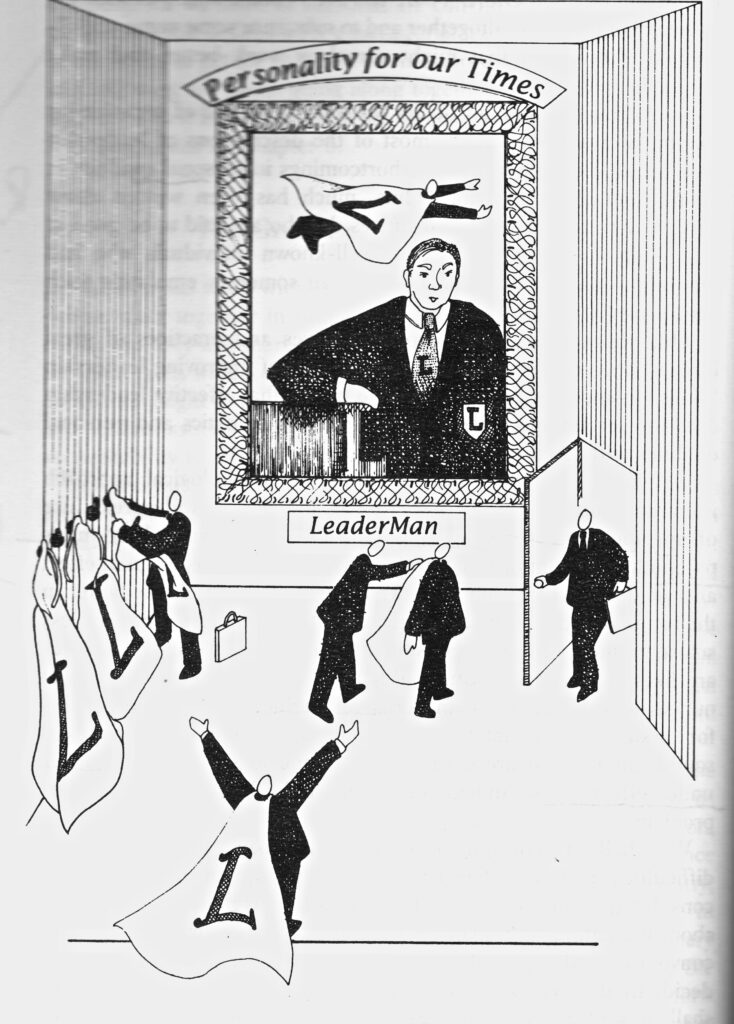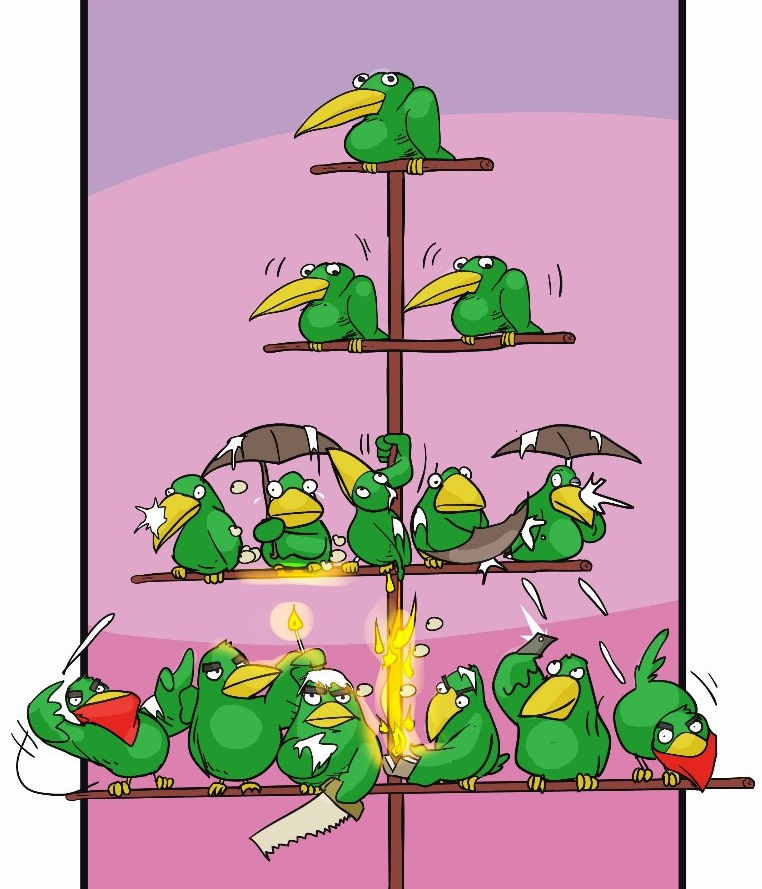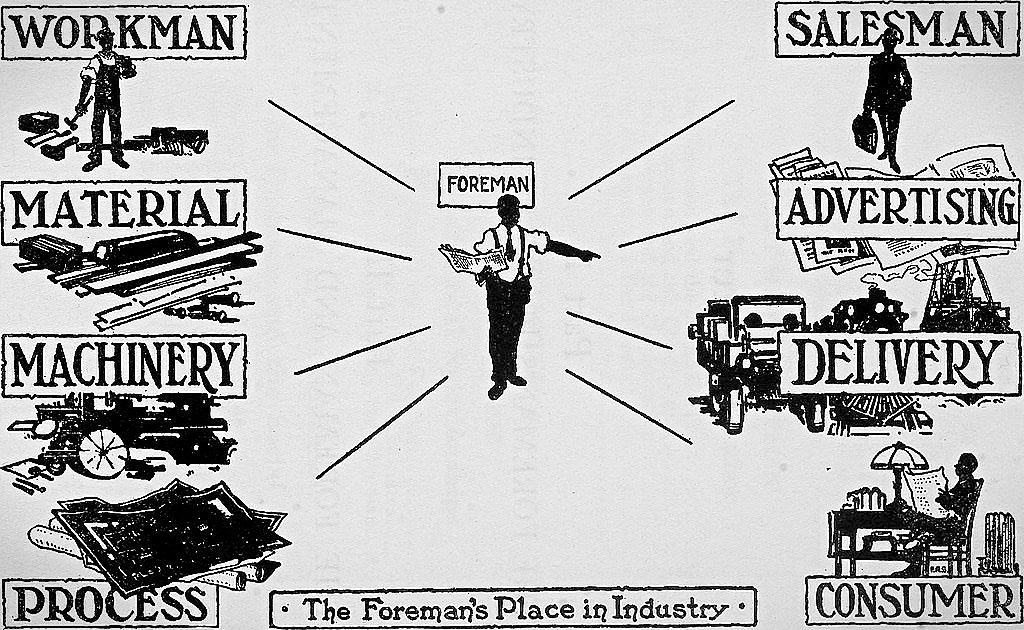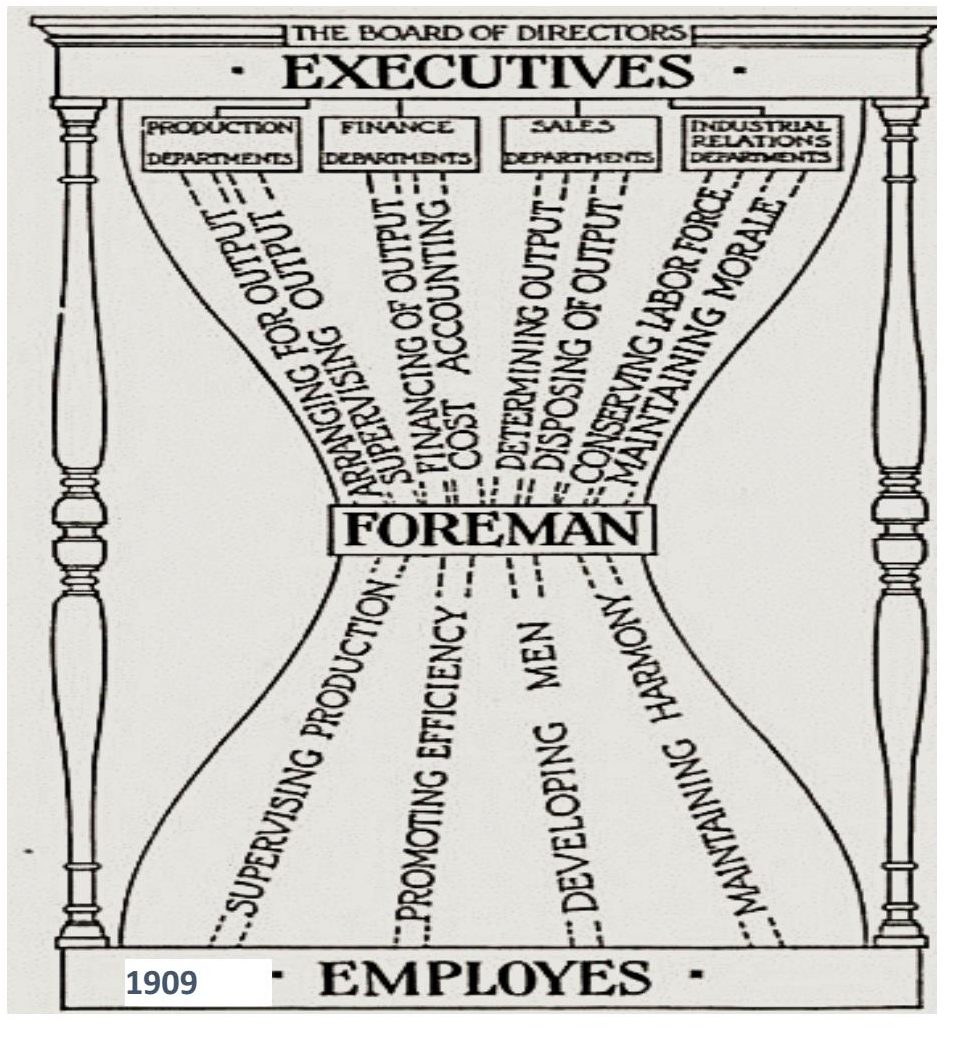Keystone to Plan B Prosperity
From this page forward through this gallery of pages, the discussion is aimed at the MitM/Keystone/foreman involved with Plan B. Since we have decades of experience with the foreman class, we closely monitor their hyperlearning progress. Keystones are engaged in testing concepts with their revenue crew, taught and paced by the interventionist. For those with no concept test laboratory, getting to Plan B in a reasonable time frame is unlikely.
The Brit Hugh Clegg wrote about the social treatment of the foreman, 1885-1925, as the forgotten man of industry. “The foreman was symbolized by a bowler hat and a watch chain, neither management nor worker, the man in the middle.” Clegg noted that after WWI, management stifled the foreman, “under which the whole efficiency of the enterprise depended.”
For two centuries, management convinced itself that orchestrating bonus systems would lead to increased productivity. This attempt to bypass the foreman failed from the start. Management considered each failure to be a reason to change the bonus system, not the concept itself. The goal of management to eliminate decision-making in production by financial incentive design was a colossal, protracted experiment that wasted trillions of dollars. No lessons were learned by management from the experience.
The flow of discussion in this gallery starts with presenting the claims for Plan B followed by the evidence to support those claims. What follows claims and evidence is the generic process by which Plan A is overwritten by Plan B through the FLLP.
Labour was the first price, the original purchase – money that was paid for all things. It was not by gold or by silver, but by labour, that all wealth of the world was originally purchased. Who controls labor, controls the economy. Adam Smith
Initialization
The ruling class, entitled consumers preoccupied with social status by authority and contemptuous of the workforce, deliberately remains ignorant of the keystone of the revenue crew. The head shed is authorized by law to destroy the keystones. No matter, the keystones remain the backbone of production. The transposition from A to B mode must focus on the organizational workforce keystone as prime mover or all is lost. Fifty years of trying to make Taylor’s “functional foremanship” work ended in total failure, more so because no lessons were learned from the $1T investment. When the strategy fails there are two categories of cost:
- The sunk cost lost due to the failure to fix OD
- The money lost to lost opportunities embedded in Plan B
Every hierarchical social system with more than three levels has two keystone roles. As stated, the keystone level in the producer hierarchy is the focal point of Plan B. By performance of his role, he is the only vector possible for bringing the organization into sustained prosperity. The keystone level in the upper hierarchy of consumers is the Plan A CEO, who can deploy his topmost legal authority only to bring negative change into his collective. No one can establish a flourishing social system by force and punishment. Drive/force is received by the workforce as the betrayal of trust and sabotage is the response. Meanwhile, prosperity is delivered via the lower-hierarchy keystone or it doesn’t happen at all.
Everyone knows about the Plan A CEO keystone of obstruction, threats, and the punishments he delivers. The top rungs of the organization are into social status by domination as a vocation and their venue is the rut of zero-sum competition over a fixed amount of authority. This is a core reason why the universal assumption of “Top Down” has never worked in the operational reality.
The keystone role of Plan B flourishing is the front-line leader, a MitM foreman, workmaster as per the above 1909 graphic. Few today recognize the foreman as the keystone to organizational prosperity. His attention is focused on improving workforce performance, not joining the incessant head shed brawls over authority-based social status.
Reality centering is mostly gaining knowledge about system dynamics, cause/effect processes. Component knowledge does not suggest system performance. In system case history, the designers prediction of the significant variables is invariably amiss. That is why dynamic simulation of systems is so central to successful design.
These two keystones do not appear and disappear depending on which operating paradigm is running the organization. When the organization is in dysfunction, Plan A, and the CEO keystone is relentlessly hammering his counterpart keystone into impotency, the MitM role is still the keystone role of Plan B. When the organization is flourishing, the savvy CEO will take full credit. The sociopath CEOs go on a Plan B vendetta. Guess the popular choice.
You can readily identify the Plan A keystone of the upper hierarchy. He’s the king of the hill. As CEO, he operates by fear (drive) to homogenize the workforce. He removes inalienable rights so he can maintain Plan A stability by driving rule-based behavior people into a bait ball. We elaborate on the Plan B keystone, a role very few appreciate, one that the Establishment denies. As mentioned above, Frederick Winslow Taylor and his followers worked tirelessly to eliminate the foreman’s role for decades (functional foremanship). It was a pursuit of the impossible Rudolf Starkermann would derive in mathematical physics.

The Plan B keystone role
Attaining and sustaining Plan B requires an effective instrument of change into the hierarchy and his capability (has his act together) to establish trust, the essential context of Plan B collaboration. It has never been the head shed, even by accident.
Understand that if the Plan B keystone role is unfulfilled, for any reason, Plan B is DOA. Nothing else in social science matters to reaching the Plan B state. History contains no examples where the transformation to Plan B was ever accomplished by “leadership,” by financial incentives, or a workman in the trenches. All attempted workarounds to the foreman failed.
The concept of keystone species is known, but it is not a concept recognizable to those in the specialized, uncoordinated disciplines of social behavior. In nature, keystone species are those which have an extremely high impact on a particular ecosystem population relative to its composition. Keystone species are critical to the overall structure and function of a biological ecosystem for the same reason all arches require keystones to fulfill their structural load-bearing purpose. The first experiments, involving tidal pools that included starfish, leading to the keystone discovery, began over fifty years ago. The Oregon pioneer of the field is still active.
As yet, there is no general formula for determining the keystone species in an ecosystem without field testing. Most ecosystems have yet to be keystone-classified. The keystone is not always the top predator or the most numerous species. Determining the keystone is basically throwing one species out of the target ecosystem at a time and seeing what changes take place in the residual arrangement. Determining the generic formula for an ecosystem is definitely a subject for dynamic simulation using the ecosystem laws, basically mathematical physics.
The head shed spotlighted the keystone of prosperity by strangling the foreman into impotency. When we restored potency to the MitM role in 2013, the ecology of the workforce made a dramatic change for the better.
For kelp fields, e.g., the keystone species is the otter. No urchin-eating otters, no kelp and the rest of the many species depending on the kelp as home base. This is a very slow process for a complex material ecosystem. It took decades for Yellowstone to learn about its keystone wolves. In contrast, for a human social system, no inertia, it can be established in a day. You can validate the two keystone roles for yourself by referring to your own experience.
Keystones are keystones not by what they are but by implementing what their role requires – their performance. Plan A keystones are determined by dominance, and class distinction. Whoever wins the zero-sum competition for social influence by domination gets the title of supreme authority. Since domination betrays trust, the Plan A keystone is powerless to increase organizational prosperity. He can only display the power of his authority by destroying the organization placed under his charge. He is imprudent by role.
Plan B keystones are measured by performance towards social flourishing. The workmaster role is the only role positioned to advance productivity. When the MitM pulls it off with his gang, his status is elevated by the appreciation freely conveyed by his workers, noticed by all the surrounding workforces.
There are two primary choices in life: to accept conditions as they exist, or accept the responsibility for changing them. Denis Waitley
MitM, front line leader, as keystone of Plan B
The entirely-subconscious notion of leadership has a checkered history, none of it good. While we have no satisfactory definition of leadership either, whatever leadership is, it’s measured exclusively and entirely by the attainments of the led. It is apart from leader attributes. The leadership process is essentially a series of goal-seeking experiences seen through the eyes of the followers. If the “leader” seeks social status by dominance, he cannot also deliver prosperity. The very acts of domination by threat of punishments prevent it. If the keystone is showing top performance towards social prosperity, he is automatically accorded the rank of “leader” by the led.
No man makes it to adulthood without being a worker in some Plan A social system trench. As low man on the totem pole, you did as your foreman/master/leader instructed you. We all did. The highly successful master-apprentice arrangement goes back millennia, before Stonehenge. Social animal species have apprenticed their young for millions of years.
The master/apprentice relationship does not move in position, role or functionality no matter how many levels are stacked up in the hierarchical pile. In our military service as foot soldiers, changing generals changed nothing. Changing platoon/squad leaders, keystone turnover, was a traumatic event. The point is that no level above keystone matters to platoon performance and effectiveness in a high-stakes battle situation.
In like manner, the levels above keystone in any hierarchy don’t matter to Plan B keystone functionality. The head shed, middle management, and general staff don’t make a whit of difference to the MitM when it comes to Plan B operations. He, and he alone, holds autonomy as his inalienable right commensurate with his taking responsibility for fulfilling his role. Authentic responsibility for organizational prosperity and autonomy comes attached to freedom to act or all bets are off. Nobody can hold the keystone accountable for results, because no one but the keystone himself can be the running reference for process due diligence. All else is second-guessing. In the FLLP, the keystones encourage each other.
Since all social systems are networks of entangled subconscious minds, having no inertia, the keystone/worker relationship can change in voltage and polarity in an instant. In your experience you have often turned such knobs yourself. The speed of adaptation to context is how, exactly, demonstrations of Plan B principles can be done so quickly in your organization.
Plan B keystones create jobs. Having no “boss,” reporting only to himself, the MitM keystone has the unilateral power to increase productivity. Certainly you have never believed that threat and punishment was key to creative prosperity. Slaves did not build Khufu’s pyramid and the whip never worked on you.

The Plan B keystone man in every hierarchy, about 8% of the population in tall hierarchies, is the front line leader. As your experience attests, in a two level hierarchy, the keystone for Plan A or Plan B is the same workmaster role. For multiple incontestable reasons, in a hierarchy taller than three levels, master/apprentice, the Plan B keystone cannot be the top dude. Never, ever. In Plan A organizations, the groupthink doctrine insists that the CEO is omniscient, omnipotent, and infallible and, by virtue of his legally-inured paramount authority, ex officio keystone to everything. All Plan B leadership is graded by the achievements of the led.
In the last two hundred years, in the most expensive social experiment in human history, millions of lives and a quadrillion dollars have been wasted attempting to bolster the top-down assumption of command omnipotence. The dismal failure of the anointed king as keystone of prosperity has been well recorded for over a century. As more and more research shows that management personality is an idle gear in the social machinery, the result is the production of more and more books about the personality specifications for leadership. The cartoon of “Leaderman” below dates back to the post-WWII proliferation of graduate schools for executives. The embarrassing record of their graduates in service speaks for itself. The worth of Plan B leaders is determined by the achievements of the led.
Nothing, as the history of human civilization has amply proved, is so expensive as a victory over men. Henry S. Dennison
CEO as keystone of Plan A
As top predator and less than 1% of the population, the CEO is the keystone of Plan A. An examination of the long record on CEO leadership speaks for itself. Since 1820, there have been more than 3.5 billion articles written about it, more than 499 million books on it, and more than 419 million studies (psychology, sociology, anthropology, business and other fields) performed. The payoff?
We have more information now than we can use and less knowledge and understanding than we need….The more that is written about leadership, the less we seem to know. Warren Bennis
Leadership is one of the most observed and least understood phenomena on Earth. J M Burns
The number of Books and essays on the MitM keystone of Plan B? Zero. Let’s summarize, the scorecard shows CEO as 4.5 billion; MitM rare. Is social dysfunction starting to make more sense as a psychological issue?

The track record on CEO Plan A leadership also speaks for itself. Tall hierarchy performance has been a disaster for the stakeholders and the public at large. As a MitM, you are keenly aware of the consequences to the workforce. The evidence is voluminous.
In his keystone role, it is imperative that the MitM understand that his entire reason for being, his role, is delivering organizational prosperity. His success as a leader is quantitatively measured by the achievements of those he leads, an opinion, nothing else. In justifying his role and position, the keystone avoids any reference to workforce abuse or management atrocities. Nothing on class warfare. Nothing to raise workers from poverty and ill-health. Nothing against management’s sabotage of organizational productivity (Veblen). No appeal to morals, ethics, or fairness. There is only one Plan B keystone mantra to utter and that is deliver a flourishing enterprise. When he does, and looks around, he will find all the side issues took care of themselves.

The history of all other reasons for leaving Plan A for something better is clear. Any skirmish is considered class warfare. Don’t fret over the truth, that Plan B will accomplish all the goals that bring the workforce to security and psychological success as side effects. The workforce doesn’t care how prosperity, eudaimonia, is reached.
As you know from experience, Plan A is preoccupied with the personality traits of its roster and the varied landscape of its prejudices. Management thinking goes “level the bias variations by force and cooperation will thrive on rule-based automatic.” In fact, calling attention to the myriad cognitive biases makes them worse.
In Plan B the bias issue is ignored. The focus on productivity is prejudice-free. People that perform well in goal seeking are appreciated and those that don’t are not, regardless of credentials or moral purity of intentions. In implementation, the workforce recognizes the variety but neutralizes it with reciprocal humor, and when that eventually includes the keystone, the foreman knows he’s on target.
Getting to Plan B
The need to be working exclusively with the authentic Plan B keystones is requisite for the Front Line Leader Program (FLLP), an example of adult hyper-learning you have to see to believe. Whereas the retention of training material in typical venues is less than 10%, the FLLP exceeds 80% retention.
Hyper-learning is a trust-based system that, for the organization to benefit, must begin with the act-together MitM.
Because getting to Plan B status is a pole vault, not a marathon, we established hyper-learning conditions. It takes warp-drive trust-building to establish hyper-learning to reach Plan B. This innovation, featured in the “trust” page, next, tests everything you thought you knew about trust.
To understand the actual world as it is, a farrago, not as we should wish it to be, is the beginning of wisdom. Bertrand Russell

Recognition of the MitM as the keystone species of Plan B human society is central. It is milestone one. It means you can take everything else you have about social system structure and organizational charts in your repertoire and throw it away. Included in the rubbish are:
- The upper management hierarchy
- Personality profiles
- Credentials
- The organizational chart
- Social system history, academia
- Chain of command, top-down power and control
- Management by “drive,” fear
- Dispensation of punishment
- Wage incentives
Only the MitM, as Plan B keystone, can have the level of security and self-confidence to launch the requisite high-stakes trust-building process. The Plan B keystone without his workforce in mutual trust mode cannot fulfill his role. In this way the keystone (structure) and trust (process) become mutually interdependent variables. One cannot exist in Plan B without the other.
Because of its importance, take your time assimilating the keystone concept. There is no going forward towards Plan B without working the algorithm through the MitM/keystone role. Watch a documentary or two about the discovery of keystone species in ecological systems. They are fascinating and definitive.
The MitM must possess several attributes together in order to fulfill his Plan B role. Just getting assigned to the front line leader slot is not the end of it. Without the mutual trust of your workforce, you are a management lackey herding your men with threats of punishment straight into distrust. Instead of collaboration to get better, you get scheming to get even. In these miserable situations, workforce distrust of their foremen always wins the day. The kicker is the fact that dysfunction creates anxiety about the future, which takes up so much of the subconscious mind resources that it distorts perceptions of reality.
Like Dorothy and the yellow brick road to Oz, the MitM must have his act together before taking the first step. Trust building begins at home. To be trustworthy to others you must be trustworthy to yourself. Achieving this requisite condition is not as simple as it may appear. The matter of “trust” is wholly contained and managed by your powerful subconscious mind. You cannot “will” trustworthiness with your sluggish conscious mind any more than you can will your trust-busting testosterone levels to go down. You can’t cheat the subconscious mind. It chooses actions too fast to be interrupted with facts.
If you’re not focusing everything social on supporting the MitM keystone, you’re not heading towards Plan B. The Law has sided with management in legalizing Plan A norms.
Legal Status of Foremen’s Unions
The national Labor Relations Act guarantees the rights of employees “to self-organization, to form, join, or assist labor organizations, to bargain collectively through representatives of their own choosing, and to engage in concerted activities for the purpose of collective bargaining or other mutual aid or protection.” Any interference by employers with these activities of employees, or any participation in them by employers, is prohibited. According to the definitions of the act:
Mediation machinery of the National Labor Relations Board has been established on the general principle that industrial relations have only two constituents, management and labor. This arbitrary division leaves foremen in what they consider an anomalous position; corporation officials and some labor leaders regard the foremen as “management” but the foremen regard themselves as either “labor” or as a group entirely apart from the management-labor dichotomy. Supervisory workers seem by these definitions to be classed both with employers and with employees. (The man in the middle)
The sharp distinction between management and labor was generally maintained until June 15, 1942, when the N. L. R. B. ruled that an independent union of supervisory employees in certain mines of the Union Collieries Coal Company constituted an appropriate unit for collective bargaining and directed that an election be held to determine the right of the union to recognition by the company.
Certain questions should be determined by the board before it grants bargaining privileges to foremen’s unions. These were: (1) What is the place in the managerial hierarchy of personnel claiming bargaining rights? (2) What would be the effect upon unions of workers if the privileges of bargaining were granted in any specific case to foremen? (3) Would the according of bargaining privileges to any union of foremen promote labor peace or labor unrest? The function of foremen in industry is a managerial one, and asserted that their loyalty should not be divided between management and a union.
To permit these foremen to renounce single-minded allegiance to management, to ally themselves in the same union with the production employees, and at the same time expect them to retain their-places at the conference table in the capacity of management spokesmen will create a form of conflict of interest which the entire history of Anglo-American jurisprudence condemns. On the other hand, exclusion of these assistant foremen from the conference table would leave a gap in the hierarchy of management which perhaps could not be filled by those in more exalted positions of authority.
The equifinality of the MitM-keystone role
The exclusive role of the MitM foreman is fixed by Nature Herself. The master/apprentice relationship cannot be changed, shared or delegated. In the last two centuries, trillion$ have been wasted by management sabotaging the front line leader role so as to impair his ability to bring prosperity, a vital function permanently denied to the ruling class. Yes, the head shed scuttles its own boat for no other reason than to show the foremen who has the “authority.” How sapiens is that?
The MitMs that enter the FLLP have been socially conditioned to accept whatever punishment management dishes out as Plan A divine destiny. Obedience to authority takes precedent over common sense and direct experience so that the foremen in Plan A assume they are being punished by the organization for valid cause. The interventionist thereby inherits a class of foremen entering the FLLP as psychologically-damaged goods.
Accordingly, the first milestone in the FLLP, after personalization, is walking the foreman through the principles and facts that define their organically-unique role as keystone of Plan B, midwife of prosperity. This necessity is where having a group of foremen learn the basics of their role together pays off. When the truth is ascertained by a couple of MitMs, psychological flashover usually brings in the rest. Their power to deliver on the foreman’s role becomes obvious in their daily experience at work. As you can imagine, there are a lot of “Holy Schmidts” echoed about during this burst of awareness.
There are three independent factors that point to the front-line supervisor role as instrumental and critical to organizational viability:
- Actionable Quality Information (AQI) – the 2½ rule
- High-stakes trust, demonstration by implementation
- The FF (Franceschi Fitting) – connecting vision to implementation without gaps
While there are additional pointers, these three independent factors are rooted in solid principles. When dealing with prosperity, you are dealing with brutish, material reality. You can have all the delusions of grandeur you want but they won’t get you a loaf of bread.

AQI
Attempting to deal with material reality using fiction is reckless stupidity on its face. GIGO has never solved a problem or engendered trust. Fiction enters-in and takes over operations simply by following the herd or doing nothing.
There can be no doubt that developing and validating actionable quality information (AQI) takes a lot of work, both by your mind and your efforts. Actionable Quality Information is necessarily produced from “ground truth,” local, particular, and timely. The 2½ rule dictates that ground truth can retain its fidelity for no more than 2½ layers of hierarchy before turning into GIGO. While the “telephone game” brings that fact home on a personal-experience basis, it is control theory which underwrites the rule. Determination of the participants to defy the 2½ rule has nothing to do with the result. Rudolf Starkermann ran thousands of dynamic simulations structured on control theory that put the issue to bed.

Because the keystone is engaging material reality with the workers, cheek by jowl, he has AQI congruent with the workforce. He can send his AQI up towards higher levels of the hierarchy, but AQI can’t come down from of any of them to support productivity. Thus, the keystone is the paramount source of AQI for Plan B because other sources are impossible.
Generality is, indeed, an indispensable ingredient of reality; for mere individual existence or actuality without any regularity whatever is a nullity. Chaos is pure nothing. Charles Sanders Peirce 1885
The keystone from “vision” to material reality
People are predisposed and socially-conditioned to assign the translation of “visions” into the operational reality to supernatural forces. All cultures answer the questions about the origins of reality in terms of their local experience. No two cultures have the same story of genesis. The one common denominator all share is that the tribal story is infallible truth and immune to questioning.
People today are socially-conditioned to believe that highly abstract imperatives “point” at particulars, that telling you to “raise productivity,” e.g., is an instruction that tells you exactly what to do next towards its attainment. Piles of information and generalized statements, by themselves, point nowhere at all.
Human creativity is the necessary and only connector that takes the abstract, generalized objectives and, level by level, step by step, brings them down to tangibles – something that has a catalog number and an implementation a worker can handle. The most crucial link chain, by far, called the Franceschi Fitting, is transmuting abstract functions into physical functions, an act of informed genius. Once the physical functions are specified, the means to execute them, while still creative, are more readily available. Responsibility is defined layer by layer by the individual making the abstract to more tangible transmutation. What starts off as visions of grandeur ends up as catalog part numbers workers can assemble and operate. The top-down breakdown below was popularized by Jens Rasmussen.
- Vision
- Prime function
- Generalized functions
- Physical functions
- Material, tangible objects and process
In the typical Plan A organization, no one knows about the translation process going on behind the scene or who is responsible for what transposition. The simple fact that workers are generating revenue means that the translation process occurred. The fact that it was done covertly by disjointed incrementalism, rather than overtly, matters not a bit to what had to take place. When things don’t work out in the operational reality, no one is to blame for the consequences and nobody goes to jail.
As far as the keystone is concerned, whoever picks parts that go into the system owns responsibility for system behavior and is apprised of that fact.
In plan B, the staircase of transformations of kind is made overt and transparent. Responsibility is taken every step of the way by those making the choices. The foreman keystone role:
- Validate the translation of generalized functions into physical functions. Colossal mistakes can be made by prior others during this step.
- Participate in the translation of physical functions to part numbers. Assume responsibility.
- Implement the construction of parts into an operable system. Take responsibility for configuration and operation to deliver specified functionality.
What “Done” looks like
The paramount objective in any human endeavor, Crusoe or collective task action, is generating surplus. Instinctively, you never stop production when your immediate needs are satisfied because you don’t live long by cycles of feast and famine. Catch all the fish you can and then worry about preserving the surplus. It is accumulations of surplus that carry you over the inevitable lean times. Even Crusoe had lean times to get through and his man Friday had to be fed.
Considering the essential husbandry of the family for survival places more emphasis on surplus. In addition to food, there’s clothing and shelter to produce. The powerful instinct for creating surplus came with your invariant genome.
Considering the essential husbandry of the tribe for survival places even more emphasis on surplus. Now husbandry requires inter-tribal trade and local tribal surplus is the currency of barter. How else to get copper, bronze and iron for tool making for increasing productivity but to increase productivity. The salt and spice trades were predicated on the universal need to preserve surplus from spoilage.
Considering the essential husbandry of the hierarchical organization for survival places even more emphasis on producing surplus. Organizations running on distrust, Plan A, require at least 25% more resources than used by trust-based organizations, Plan Bs, to produce the same output. As long as there is enough surplus to pay the distrust transactions tax, the rule-based Plan A organization can remain viable – until the 2nd Law suffocates it to death with entropy.
Meanwhile, the keystone to surplus and prosperity, Plan B, is continuously raising productivity, which can only be sustained by entropy extraction. Plan B is change and more change, project by project to better the process.
We are accustomed to speak of ideas as reproduced, as passed from mind to mind, as similar or dissimilar to one another, and, in short, as if they were substantial things; nor can any reasonable objection be raised to such expressions. But taking the word “idea” in the sense of an event in an individual consciousness, it is clear that an idea once past is gone forever, and any supposed recurrence of it is another idea. These two ideas are not present in the same state of consciousness, and therefore cannot possibly be compared. Charles Sanders Peirce 1869
NEXT
Visits: 375


